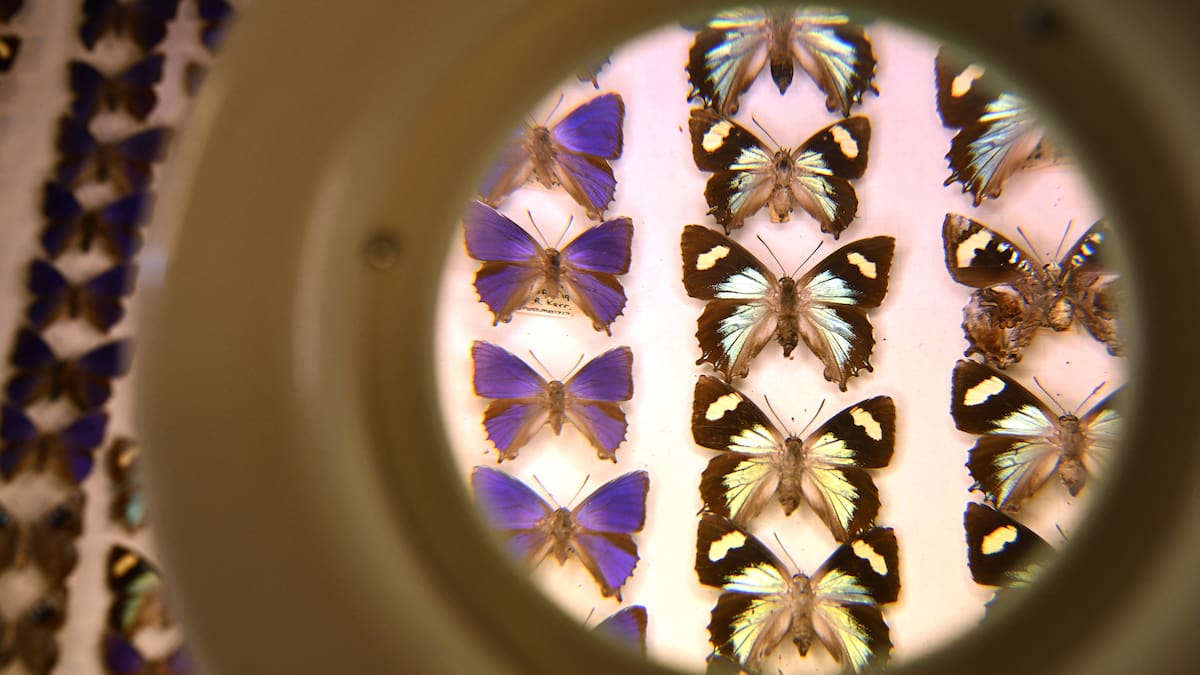Decades on, lepidopterists are still struggling to repair the damage.
“He created such a taxonomic mess, it will never really be able to be sorted out,” Museums Victoria’s head of strategic collection management Maryanne McCubbin told AFP.
“I just get so angry. It is a despicable criminal act and it has huge scientific consequences,” she said.
“He had no right to steal collections that we hold on behalf of the public.”
The numbers are staggering.
In Melbourne, Wyatt smuggled 827 lepidopterans – winged insects that include butterflies and moths – out of the museum in tin containers in a single weekend.
He stole another 1500 butterflies from a museum in Sydney as well as 603 from the Adelaide Museum.
Those butterflies now must be affixed with a label designating them as having “passed through C. W. Wyatt Theft coll. 1946–1947”.
A photo taken on August 25 shows a butterfly in the collection of the Melbourne Museum, seen with a label (top) that reads ‘passed through C. W. Wyatt Theft coll. 1946-1947’ which designates this specimen was previously stolen by British ski champion and acclaimed painter Colin Wyatt, at the museum’s premises in Melbourne. Photo / William West, AFP
“It was a really vindictive theft,” Victoria Museum collection manager of terrestrial invertebrates Simon Hinkley told AFP.
“Never in my lifetime have I seen something like this.”
Wyatt posted the almost 3000 stolen butterflies back to Britain before fleeing.
The plundered pieces included holotypes – the original specimen from when the species was first officially described.
There were also samples of rare metallic blue butterflies that often fly at the top of trees – caught by a net-wielding collector who strapped himself to tree trunks, local media reported at the time.
The empty museum drawers were not discovered until later.
But it did not take long for the museums to narrow down a suspect and contact London authorities.
Police found Wyatt at home with the stolen Australian butterflies, part of a collection nearing 40,000, Time magazine reported at the time.
A British judge let him off with a £100 fine, equivalent to £5000 ($11,500) today.
The Australian specimens were repatriated, with staff from the three facilities taking more than nine days to sort the colourful fliers and return them home.
Since the heist, museums have used taxonomists to examine butterfly collections and identify where specimen label data does not match their knowledge of that species – a never-ending puzzle.
But not all of them made it back and Wyatt’s stolen butterflies are still being found.
A precious holotype butterfly was discovered in Munich in 2022, mislabelled for almost eight decades.
Simon Hinkley, collection manager of terrestrial invertebrates at the Museums Victoria Research Institute, inspects a collection of butterflies at the Melbourne Museum. Photo / William West, AFP
It was only after a skilled entomologist spotted the Peacock Jewel and realised that it belonged to the Melbourne facility that the butterfly was returned.
The flying jewel, which has iridescent peacock-green and orange wings, will be hand-delivered to Melbourne.
In another case, a lepidopterist in Canberra found a butterfly had been painted to resemble another species and mislabelled.
Hinkley said he wonders how many more specimens are incorrectly labelled.
“If I could go back and meet him and get him before he did that, I’d be keen to ask him why he did it,” he said.
“The damage he did was significant,” he said.
“What he did messes with the whole collection … you can’t trust anything that has been through his hands.”
-Agence France-Presse

